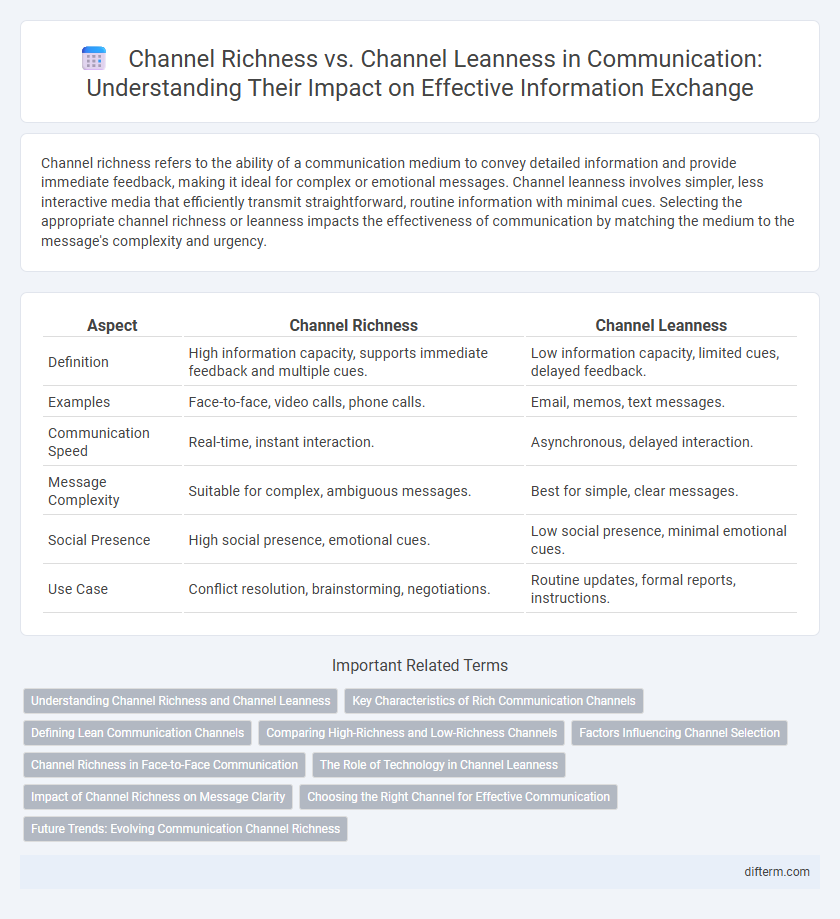Channel richness refers to the ability of a communication medium to convey detailed information and provide immediate feedback, making it ideal for complex or emotional messages. Channel leanness involves simpler, less interactive media that efficiently transmit straightforward, routine information with minimal cues. Selecting the appropriate channel richness or leanness impacts the effectiveness of communication by matching the medium to the message's complexity and urgency.
Table of Comparison
| Aspect | Channel Richness | Channel Leanness |
|---|---|---|
| Definition | High information capacity, supports immediate feedback and multiple cues. | Low information capacity, limited cues, delayed feedback. |
| Examples | Face-to-face, video calls, phone calls. | Email, memos, text messages. |
| Communication Speed | Real-time, instant interaction. | Asynchronous, delayed interaction. |
| Message Complexity | Suitable for complex, ambiguous messages. | Best for simple, clear messages. |
| Social Presence | High social presence, emotional cues. | Low social presence, minimal emotional cues. |
| Use Case | Conflict resolution, brainstorming, negotiations. | Routine updates, formal reports, instructions. |
Understanding Channel Richness and Channel Leanness
Channel richness refers to the capacity of a communication channel to convey multiple cues such as tone, body language, and immediate feedback, making it ideal for complex or ambiguous messages. In contrast, channel leanness involves using channels that transmit fewer cues, often text-based or asynchronous, suitable for straightforward and routine information. Understanding the balance between channel richness and leanness is crucial for effective communication, as it influences message clarity, engagement, and the efficiency of information exchange.
Key Characteristics of Rich Communication Channels
Rich communication channels are characterized by their ability to convey multiple cues simultaneously, such as verbal tone, facial expressions, and body language, enhancing message clarity and emotional understanding. They support immediate feedback, allowing for quick clarification and interactive dialogue, which reduces the chances of miscommunication. Examples of rich communication channels include face-to-face conversations, video calls, and phone calls, where real-time interaction and nonverbal cues play crucial roles.
Defining Lean Communication Channels
Lean communication channels convey information with minimal nonverbal cues, relying primarily on text-based formats such as emails, memos, and instant messaging. These channels are efficient for straightforward, routine exchanges but may lack the depth needed for complex or emotional messages. Understanding channel leanness helps organizations select appropriate mediums that optimize clarity while minimizing ambiguity in communication.
Comparing High-Richness and Low-Richness Channels
High-richness communication channels, such as face-to-face interactions and video calls, enable immediate feedback, multiple cues, and personal focus, enhancing message clarity and emotional connection. Low-richness channels like emails and memos lack nonverbal signals and delay feedback, which can increase misunderstanding in complex or ambiguous messages. Choosing between high-richness and low-richness channels depends on the communication goal, message complexity, and the need for speed and documentation.
Factors Influencing Channel Selection
Channel richness is influenced by factors such as the complexity of the message, the need for immediate feedback, and the degree of personal involvement required. In contrast, channel leanness suits routine or straightforward messages where minimal social cues are necessary. The choice between rich and lean communication channels depends on factors like urgency, message ambiguity, and the importance of nonverbal signals.
Channel Richness in Face-to-Face Communication
Face-to-face communication exemplifies high channel richness by enabling immediate feedback, multiple cues such as tone, facial expressions, and body language, and a personal focus that strengthens message clarity. This richness enhances understanding, reduces ambiguity, and builds stronger interpersonal relationships. The dynamic interaction in face-to-face settings supports complex and sensitive information exchange more effectively than leaner communication channels.
The Role of Technology in Channel Leanness
Technology plays a crucial role in channel leanness by enabling streamlined, cost-effective communication with reduced nonverbal cues. Digital platforms such as email and instant messaging prioritize speed and efficiency but sacrifice richness by limiting tone, body language, and immediate feedback. Organizations must balance these lean channels with richer alternatives to ensure clear understanding and effective interaction.
Impact of Channel Richness on Message Clarity
Channel richness significantly enhances message clarity by providing multiple cues such as tone, body language, and immediate feedback, which help reduce misunderstandings and ambiguity. Rich communication channels like face-to-face meetings or video calls facilitate nuanced conversations, allowing the sender to tailor messages in real-time and the receiver to interpret intent accurately. This dynamic interaction improves comprehension, engagement, and overall effectiveness in conveying complex or sensitive information.
Choosing the Right Channel for Effective Communication
Selecting the appropriate communication channel depends on channel richness, which refers to the ability to convey multiple cues such as tone, body language, and immediate feedback, essential for complex or sensitive messages. For straightforward or routine information, channel leanness enhances efficiency by minimizing unnecessary detail and allowing quick dissemination through emails or memos. Matching the channel to the message complexity improves clarity, reduces misunderstandings, and boosts overall communication effectiveness in organizational settings.
Future Trends: Evolving Communication Channel Richness
Future trends in communication emphasize increasing channel richness through enhanced sensory engagement, real-time interactivity, and adaptive AI integration. Emerging technologies like virtual reality (VR), augmented reality (AR), and immersive video conferencing amplify nonverbal cues, emotional context, and immediate feedback, bridging gaps in digital communication. Organizations leveraging these advancements achieve higher message clarity, collaboration efficiency, and user satisfaction, redefining effective communication strategies in dynamic environments.
Channel Richness vs Channel Leanness Infographic

 difterm.com
difterm.com